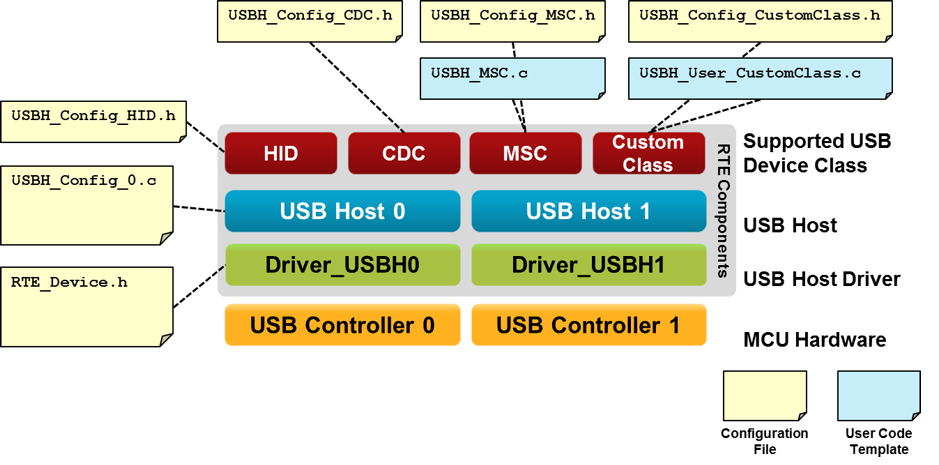 |
USB Component
Version 6.6
MDK-Professional Middleware for USB Device and Host
|
 |
USB Component
Version 6.6
MDK-Professional Middleware for USB Device and Host
|
Structure of the USB Host Component and its use for creating application.
This chapter describes the software structure of an USB Host Component and explains its use for creating an USB Host application.
The USB Host Component simplifies software development of microcontroller systems that allow to connect USB Devices. The attributes of the USB Host Component are:
The following picture shows the relationships of the RTE Components with the microcontroller's USB Host peripheral (USB Controller). RTE Components provide configuration files and user code templates. Configuration files configure the RTE Components, hardware interfaces, memory resources and USB Host parameters. User code templates provide the skeleton for implementing support for different USB Device classes.

The steps to create a microcontroller application that functions as an USB Host are:
The RTE Component selection is done in a few steps:

The USB Host Driver and the USB Controller of the microcontroller need to be correctly configured. In particular this means:
The USBH_Config_n.c file contains additional settings for the specific USB Host:
Refer to Configuration for a detailed list of all available settings.
For proper operation, the USB Host Component requires some system configuration settings. The requirements are:
Stack_Size).For more information, check the USB Host component's Resource Requirements section.
In the USBH_Config_HID.h, USBH_Config_MSC.h, USBH_Config_CDC.h, or USBH_Config_CustomClass.h you can specify the number of concurrent USB Devices that the USB Host will support. This has an impact on the amount of memory that will be reserved in your application for the attachment of USB Devices. The USB Host Examples shows how to configure an USB Host to interact with different HID, MSC or CDC peripheral devices.
User code template files provide function templates to support various USB Device Classes on the USB Host. The available functions are explained in the Reference section of the USB Host Component. These routines can be adapted to the needs of the microcontroller application, in case different then default functionality is needed.
The following templates are available for the USB Host component:
| Template Name | Purpose |
|---|---|
| USBH_MSC.c | Required functions to support MSC devices. The template can be found here. |
| USBH_PL2303.c | Required functions to support the Prolific PL2303 USB to serial RS232 adapter. The template can be found here. |
| USBH_User_CustomClass.c | Required functions to support any USB Device class. The template can be found here. |